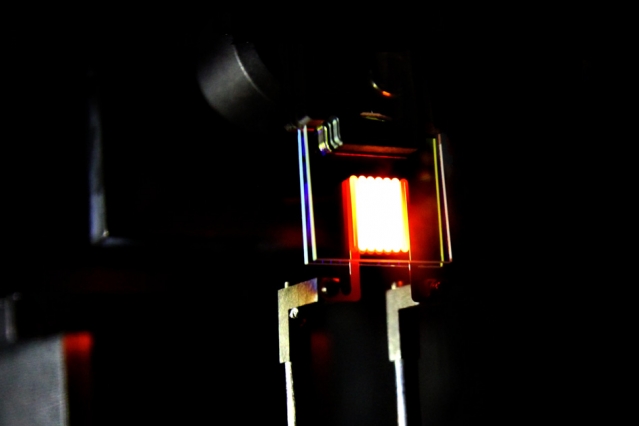A team of scientists from MIT and Purdue University have developed an innovative technology that combines the warm look of conventional incandescent light bulbs with improved energy efficiency. This latest breakthrough could potentially revive the century-old incandescent bulbs.
 A proof-of-concept device built by MIT researchers demonstrates the principle of a two-stage process to make incandescent bulbs more efficient. This device already achieves efficiency comparable to some compact fluorescent and LED bulbs. Courtesy of the researchers
A proof-of-concept device built by MIT researchers demonstrates the principle of a two-stage process to make incandescent bulbs more efficient. This device already achieves efficiency comparable to some compact fluorescent and LED bulbs. Courtesy of the researchers
Developed by Thomas Edison, incandescent bulbs have been in use for more than 100 years and continue to be used in homes worldwide. They operate by heating an ultra-thin tungsten wire to around 2,700 degrees Celsius. This hot wire then generates a broad spectrum of light called black body radiation, which provides a warm glow and a faithful rendering of all colors in a scene. However, a major drawback of incandescent bulbs is that over 95% of the energy entering them is then wasted in the form of heat. Many nations have now either banned or are phasing out this traditional lighting in favor of modern, light-emitting diode (LED) bulbs, and more energy efficient, compact fluorescent bulbs (CFLs).
However, despite these misgivings, the innovative technology developed by the researchers may potentially reprieve this inefficient technology. The team of MIT researchers consisted of Marin Soljačić, professor of physics; Gang Chen, the Carl Richard Soderberg Professor in Power Engineering; John Joannopoulos, the Francis Wright Davis Professor of Physics; MIT principal research scientist Ivan Celanovic; MIT alumnus and Purdue physics professor Peter Bermel PhD ’07; and postdoc Ognjen Ilic. The study results were reported in the journal, Nature Nanotechnology.
According to the research team, a two-stage process is critical to realize this feat. In the first stage, a traditional heated metal filament is used along with all its attendant losses, the difference here being that the waste heat is not allowed to disperse as infrared radiation. Instead, this infrared radiation is captured by secondary structures enclosing the filament, it is then reflected back to the filament so that it can be re-absorbed and re-emitted as visible light. As a form of photonic crystal, these structures are made from Earth-abundant elements and can be developed using a standard material-deposition technology.
The second stage makes a difference in the efficiency of converting electricity into light. Luminous efficiency is the characteristic of the response the human eye has to a lighting source. In incandescent lights and fluorescent lights, the luminous efficiency ranges between 2 and 3% and 7 and 15%, respectively. Most LEDs have luminous efficiency between 5 and 15%. However, the new two-stage incandescent units developed by the researchers could have luminous efficiency of up to 40%.
The first proof-of-concept units developed by the researchers are yet to reach this level, approximately 6.6% efficiency was achieved. Though the preliminary results matched the efficiency of some CFLs and LEDs, it also has shown a threefold improvement over present-day incandescent bulbs. Ilic informed that this method has been dubbed "light recycling" as the material absorbs unwanted energy wavelengths and changes them into the preferred visible light wavelengths.
It recycles the energy that would otherwise be wasted.
Marin Soljačić, Professor of Physics
In fact, the development of the photonic crystal was integral to the team’s success. The crystal was designed as a stack of thin layers deposited on a substrate.
The newly developed system allows the desired visible wavelengths to pass through the material and exit the bulb. However, the infrared wavelengths are reflected which then go back to the filament, producing additional heat and eventually being converted into more visible light. As only the visible wavelengths can get out, the heat continues to reflect back toward the filament until it ends up as visible light.
The results are quite impressive, demonstrating luminosity and power efficiencies that rival those of conventional sources including fluorescent and LED bulbs. [The findings] provide further evidence that application of novel photonic designs to old problems can lead to potentially new devices. I believe that this work will reinvigorate and set the stage for further studies of incandescence emitters, paving the way for the future design of commercially scalable structures
Alejandro Rodriguez, Assistant Professor of Electrical Engineering at Princeton University,
According to Soljačić, in addition to light bulbs, the new technology holds promise for other applications. For example, this method could play a major role in the performance of thermo-photovoltaics and other similar energy-conversion systems. In the case of a thermo-photovoltaic device, the heat emitted from an external source makes a material to glow, and this material, in turn, generates light, which is changed into electricity by means of a photovoltaic absorber.
LEDs are great things, and people should be buying them. But understanding these basic properties is very important to a wide variety of things. The ability to control thermal emissions is very important. That’s the real contribution of this work.
Marin Soljačić, Professor of Physics
The Army Research Office through the MIT Institute for Soldier Nanotechnologies, and the S3TEC Energy Frontier Research Center funded by the U.S. Department of Energy supported the research work.